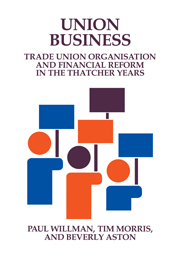Book contents
- Frontmatter
- Contents
- Acknowledgements
- 1 Introduction: unions in the 1980s
- 2 The financial status of British trade unions 1950–1989
- 3 Financial differences between unions
- 4 The role of financial matters in union organisation
- 5 The politics of union finaces
- 6 Union size, growth, and financial performance
- 7 Strike activity and union finances
- 8 The National Union of Mineworkers: strikes and financial disaster
- 9 The GMB: merger and financial reform
- 10 The Amalgamated Engineering Union: back from the brink
- 11 The Banking, Insurance and Finance Union: competitive unionism and financial survival
- 12 The Electrical, Electronic, Telecommunications and Plumbing Trade Union: accountability and financial control
- 13 Conclusions: union business and business unionism
- Appendix 1 Research methods
- Appendix 2 Regression results
- Appendix 3 Questions for finance officers
- Appendix 4 Questions for General Secretaries
- Appendix 5 Questionnaire: trade union finances
- Appendix 6 The number of trade unions
- Notes
- References
- Subject index
- Index of trade unions
- Author index
6 - Union size, growth, and financial performance
Published online by Cambridge University Press: 11 March 2010
- Frontmatter
- Contents
- Acknowledgements
- 1 Introduction: unions in the 1980s
- 2 The financial status of British trade unions 1950–1989
- 3 Financial differences between unions
- 4 The role of financial matters in union organisation
- 5 The politics of union finaces
- 6 Union size, growth, and financial performance
- 7 Strike activity and union finances
- 8 The National Union of Mineworkers: strikes and financial disaster
- 9 The GMB: merger and financial reform
- 10 The Amalgamated Engineering Union: back from the brink
- 11 The Banking, Insurance and Finance Union: competitive unionism and financial survival
- 12 The Electrical, Electronic, Telecommunications and Plumbing Trade Union: accountability and financial control
- 13 Conclusions: union business and business unionism
- Appendix 1 Research methods
- Appendix 2 Regression results
- Appendix 3 Questions for finance officers
- Appendix 4 Questions for General Secretaries
- Appendix 5 Questionnaire: trade union finances
- Appendix 6 The number of trade unions
- Notes
- References
- Subject index
- Index of trade unions
- Author index
Summary
Introduction
The literature discussed in Chapter 4 and the data in the last chapter both suggest ttiat there may be financial benefits accruing to unions by virtue of size. Larger unions can distribute fixed costs over a larger revenue base and are likely, ceteris paribus, to have more influence on employers. However, the material reviewed in Chapter 4 also suggested two other propositions; firstly, that there may be institutional or leadership benefits from growth but that, beyond a certain size, there may be no advantages to members themselves; secondly, that there may be circumstances in which growth is not cost effective in that recruitment costs outweigh subscription returns. Growth may, it appears, produce returns to all members in the form of scale economies, to leaders in the form of greater revenues, or to no one at all.
Empirically, disaggregated growth through recruitment or merger has been pursued by most large unions and concentration of membership has resulted. In 1950, 84% of union members were in the 50 largest trade unions. Since then, these unions have grown more rapidly than unions as a whole (Buchanan, 1981: 234). By 1985, they accounted for 94% of total union membership.
In this chapter, we shall examine the financial implications of growth and specifically the proposition that there are economies of scale in the provision of union services. Section 2 looks generally at theories of union growth and at the mechanisms through which unions grow. Section 3 looks directly at scale economies; in particular, it seeks to discover whether such economies can be said to exist and at the major elements of unions' costs.
- Type
- Chapter
- Information
- Union BusinessTrade Union Organisation and Financial Reform in the Thatcher Years, pp. 79 - 100Publisher: Cambridge University PressPrint publication year: 1993



